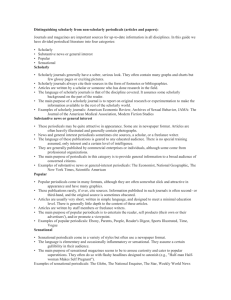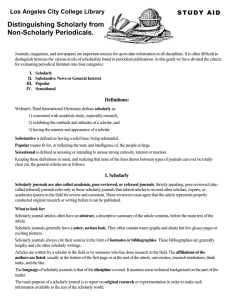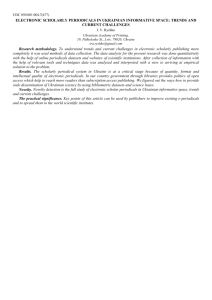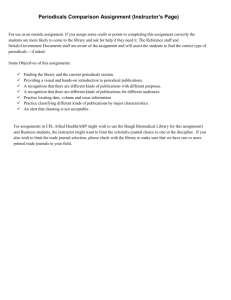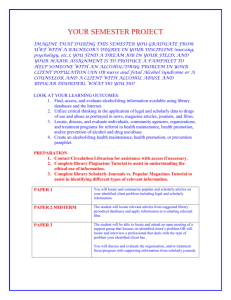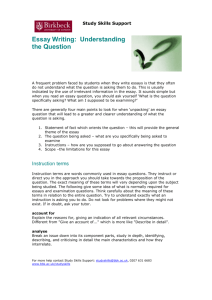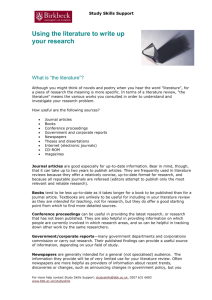Distinguishing Scholarly Journals from Other Periodicals
advertisement
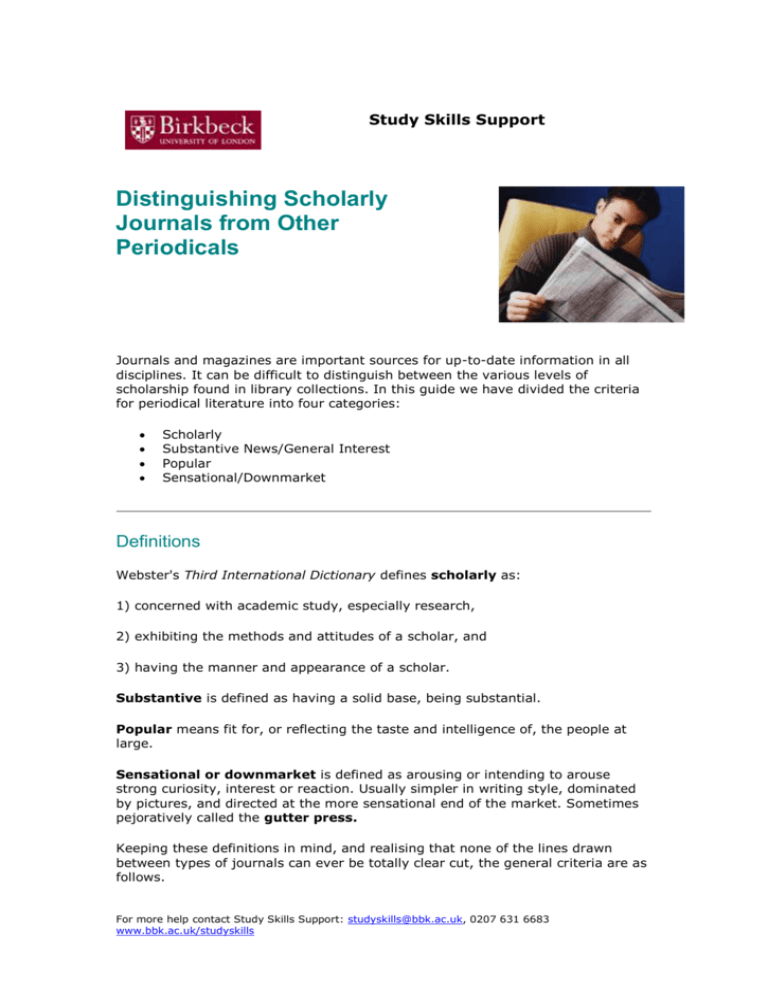
Study Skills Support Distinguishing Scholarly Journals from Other Periodicals Journals and magazines are important sources for up-to-date information in all disciplines. It can be difficult to distinguish between the various levels of scholarship found in library collections. In this guide we have divided the criteria for periodical literature into four categories: Scholarly Substantive News/General Interest Popular Sensational/Downmarket Definitions Webster's Third International Dictionary defines scholarly as: 1) concerned with academic study, especially research, 2) exhibiting the methods and attitudes of a scholar, and 3) having the manner and appearance of a scholar. Substantive is defined as having a solid base, being substantial. Popular means fit for, or reflecting the taste and intelligence of, the people at large. Sensational or downmarket is defined as arousing or intending to arouse strong curiosity, interest or reaction. Usually simpler in writing style, dominated by pictures, and directed at the more sensational end of the market. Sometimes pejoratively called the gutter press. Keeping these definitions in mind, and realising that none of the lines drawn between types of journals can ever be totally clear cut, the general criteria are as follows. For more help contact Study Skills Support: studyskills@bbk.ac.uk, 0207 631 6683 www.bbk.ac.uk/studyskills Scholarly Scholarly journal articles often have an abstract, a descriptive summary of the article contents, before the main text of the article. Scholarly journals generally have a sober, serious look. They often contain many graphs and charts but few glossy pages or exciting pictures. Scholarly journals always cite their sources in the form of footnotes or bibliographies. These bibliographies are generally lengthy and cite other scholarly writings. Articles are written by a scholar in the field or by someone who has done research in the field. The affiliations of the authors are listed, usually at the bottom of the first page or at the end of the article--universities, research institutions, think tanks, and the like. The language of scholarly journals is that of the discipline covered. It assumes some scholarly background on the part of the reader. The main purpose of a scholarly journal is to report on original research or experimentation in order to make such information available to the rest of the scholarly world. Many scholarly journals, though by no means all, are published by a specific professional organisation. EXAMPLES OF SCHOLARLY JOURNALS: Human Relations Journal of Organisational Behaviours Mathematical Structures in Computer Science Nature The Lancet The Review of English Studies Substantive news or general interest These periodicals may be quite attractive in appearance, although some are in newspaper format. Articles are often heavily illustrated, generally with photographs. News and general interest periodicals sometimes cite sources, though more often do not. Articles may be written by a member of the editorial staff, a scholar or a freelance writer. The language of these publications is geared to any educated audience. There is no specialty assumed, only interest and a certain level of intelligence. They are For more help contact Study Skills Support: studyskills@bbk.ac.uk, 0207 631 6683 www.bbk.ac.uk/studyskills generally published by commercial enterprises or individuals, although some emanate from specific professional organisations. The main purpose of periodicals in this category is to provide information, in a general manner, to a broad audience of concerned citizens. EXAMPLES OF SUBSTANTIVE NEWS OR GENERAL INTEREST PERIODICALS: Economist National Geographic New York Times Scientific American Popular Popular periodicals come in many formats, although often somewhat slick and attractive in appearance. Lots of graphics (photographs, drawings, etc.). These publications rarely, if ever, cite sources. Information published in such journals is often second or third hand and the original source is sometimes obscure. Articles are usually very short, written in simple language and are designed to meet a minimal education level. There is generally little depth to the content of these articles. The main purpose of popular periodicals is to entertain the reader, to sell products (their own or their advertisers), and/or to promote a viewpoint. EXAMPLES OF POPULAR PERIODICALS: New Scientist Time Vogue Psychology Today Country Living Good Housekeeping Sensational/Downmarket For more help contact Study Skills Support: studyskills@bbk.ac.uk, 0207 631 6683 www.bbk.ac.uk/studyskills Called “red tops” in the UK, sensational periodicals come in a variety of styles, but often use a newspaper format. Their language is elementary and occasionally inflammatory or sensational. They may assume a certain gullibility in their audience (particularly the American newspapers). The main purpose of sensational magazines seems to be to arouse curiosity and to cater to popular superstitions. They often do so with flashy headlines designed to astonish or grab attention (e.g. Sexiest Big Brother Ever; Tipsy Pixsy Suspended). EXAMPLES OF SENSATIONAL OR DOWNMARKET PERIODICALS: News of the World The Sun Daily Star For more information on individual periodical titles Ask for assistance at the library reference desk. Adapted with permission from: Reference Department Collections, Reference, Instruction & Outreach (CRIO) Cornell University Library Ithaca, NY, USA http://www.library.cornell.edu/olinuris/ref/research/skill20.html For more help contact Study Skills Support: studyskills@bbk.ac.uk, 0207 631 6683 www.bbk.ac.uk/studyskills
